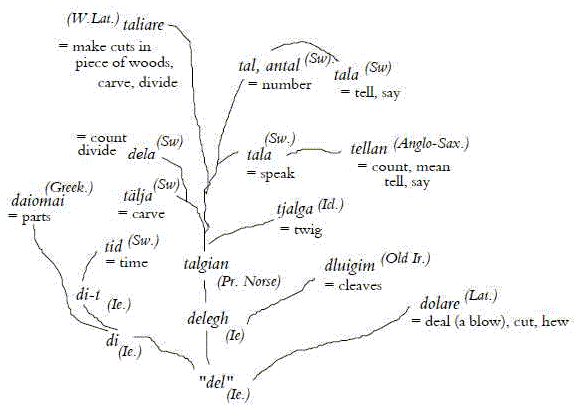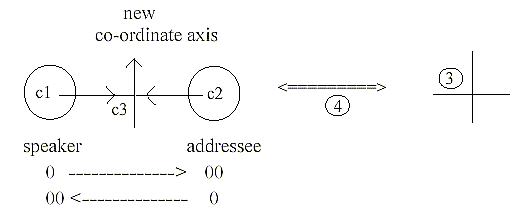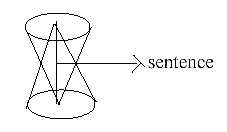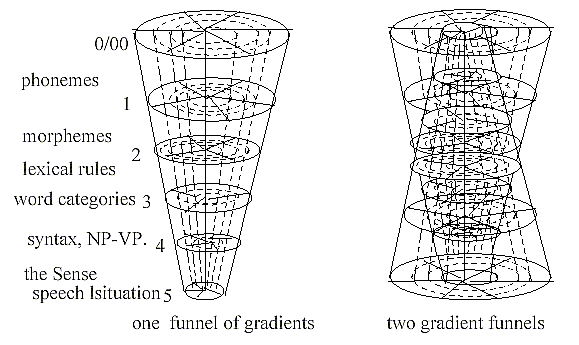|
An Indo-European word tree.

The world created through division of "the
whole",
Division = del-ning in Swedish.
Words meaning count and tell something have the same root.
Tal = "number", = "speech" in Swedish.
In Finnish too, belonging to the Uralic language family:
lukea = count, read, say.
(Used abbreviations in this figure, see
end of the file.)
1. The 5-dimensional model, presented in files
about physics,
is here applied to the structure of language.
2. The general hypothesis is that the same fundamental patterns
that govern processes on elementary physical levels also can
be expected to turn up on all superposed levels in Nature
- more or less recognizable.
3. If the model in one or another form shows up to be valid
on underlying levels as in the genetic
code and biology, it would be natural if it also reappeared
as a pattern on the superposed linguistic level. Natural both
in the motor production of language and in the speech situation,
which gives the semantic sense, the relation to the surroundings
from which human beings are precipitations and to which they
relate through language.
4. Schools among grammarians use models similar to the dimension
model here, e.g. the "tree" structures of the Chomsky
school for analysis similar to polarizations here, "derivations"
between levels, concepts as that about a deep structure in
relation to the surface level
(The linguists' tree structures should of
course be turned upside down for a more adequate tree form
(!), but our bad habit in western culture to read and write
downwards explains surely that this inversion has become the
practice.)
5. It's proposed here that this model could make up at last
one part up the basis for children's inborn ability to grasp
a grammar that Noam Chomsky launched as hypothesis, underlying
the different rule systems of individual languages.
Such a built-in cognitive structure in human
brains should probably be a very fundamental model to allow
for the thousands of variations that exist and have existed.
It seems as a reasonable hypothesis that such
a built-in structure for language is a further development
of the network for the olfactory
sense (paragraph 3). The chemical level of smells
is a system for communication in the animal kingdom, and
in the nervous system of electric signals this underlying
chemical level appear in all synapses.
6. There are at least three areas of language
where the dimension model may be applied rather easily: the
structure of humans' speech organs, the types
of phonemes - and main word categories
through which humans perceive themselves and the environment,
categories which may be connected with main word classes or
parts of sentences. Many grammatical features in different
language families are also possible to analyze and interpret
in terms of the dimension model.
7. About numbers, we have for instance up to 5 - 6 levels
in the linguists' analyses of languages, about 5-6 types of
phonemes, - with about thirty phonemes as an average value
in different languages - as the sum of poles in a dimension
chain, and we may count on about 5 to 4 elementary categories
of words...
8. Views and applications of the model in following files
may surely seem very simple - too simplified perhaps in many
cases, and generalizations become of natural reasons more
vague. Yet, even linguists by profession - as for instance
Roman Jacobson - have made use of similar dimensional
aspects in his analyses, even if it concerned a more limited
area.
Language as a force:
Speech is of course a force, analogous to the forces in physics:
an equivalent on this superposed level of relations between
living creatures as particles.
Physicists call the boson quanta "carriers
of forces". In the same sense words or speech is just
such carriers of forces between people, binding or disintegrating.
As the nuclear force and the electromagnetic
one sews up atoms and molecules, language functions as sewing
between individuals.
Two of the physical forces are called strong
or weak interaction, with quanta as π-mesons
(or "gluons") and neutrinos and others. Speech is
interaction in the same way with quanta carrying sense and
energy in the communication. (Like interchange of commodities
in the economy.)
Language may also be interpreted as a further development
from the chemical level with correspondences to chemical
laws: with "ionizations" to morphemes, with free
valences for linguistic derivations, with charges in sentences,
"radical groups", attraction and repulsion etc.
The historical development of a morpheme
or word, with branching of the signification in different
directions, has also similarities with the substances in glycolysis
and citrate cycle for instance, where the different stages
also leave the circulation to transform into other chemical
molecules with other functions.
Without entering into the question how language are stored
in the brain, it can be observed that the number of phonemes
in basic morphemes (word stems) or syllables is circa 3-2,
sometimes 4-5: the same number as number of bases in codons
in the genetic code or totally (T/U-G-C-A). However, in numbers,
it's the number of amino acids that resembles phonemes in
the "genetic alphabet".
The probable deeper relations between the coding systems
of a) the genetic code for proteins and b) language is (or
would be) an interesting area of research.
In a first view there is an obvious opposition:
Language as a way from the multidimensional sense and sentences
to linear (sequential) motor action - in opposition to proteins
as linear, through folding becoming multidimensional. The
folding of proteins, so essential for their function, and
what in the code that eventually decides this folding, is
still an unanswered question.
Speech as motions:

Language as motions out of the "angle
rest"
Also motion as such, "dimension degree
(d-degree) 0/00" in the model here, is a force in relation
to other d-degrees. "Carrier" of this force are
the bodies that move.
According to one hypothesis about the dimension
model, the steps in a dimension chain have also the character
of angle steps through 5(0) → 4 →3 →2 →1
- 0/00 (00), as e.g. halvings: 360° — 180° —
90° — 45° — 22,5° —11,25°.
Five steps give the angle rest 11,25 which could be regarded
as the germ for motions as such: language as a force translated
to motions out of this angle rest: an opening for communication
with the surroundings, the 00-pole.

Speech has two centra in human brains: Wernicke's
area in the temporal lobe for interpretation, and Broca's
area near primary motor centra for speech.
They are connected as through an arch,
"fascicutus arcuatus" (which could illustrate angle
steps).
Really basic morphemes seem possible to
manage and understand by Wernicke's centre, real syntactic
connections first in Broca's area, according to studies of
brain damages (RB).
The Situation of Speech and Types of sentences
1. The speech situation makes up the starting point for a
development from primary to secondary sentences and types
of sentences:
The speaker c1 — addressee(s) c2 — narrating
centre c3:

2. In resemblance with how the cortex of cerebrum
develops and spreads out as a projection surface over older
parts of the brain, the communication between individuals
develops from "radial" messages between speaker
and addressee to descriptions as along a circumference or
coordinate axis "in straight angle" to the line
between both parts (c3); it gets a character of projection.
(However, also the dance of bees has the narrative function,)
3. In terms of the dimension model:
First polarization 0 <———> 00, centre
— anticentre (circumference) is given in the situation
for speech in the relation speaker - addressee(s). They are
as centre - anticentre poles out of a 5-dimensional unit,
"the whole situation". Between these poles the 4th
dimension degree (d-degree) is defined, in our model proposed
as Direction, corresponding to a vector field. Speaker and
addressee (listener) become each other's anticentra.
4. This primary relation gives types of sentences with directions,
such as exclamations, exhortations, questions, ceremonial
greetings and so on, types of sentences which are valid in
"I <—> You" relations. (As developments
from animals' greeting, calling or warning signals.)
Drawing any border between languages of animals and humans
becomes difficult to justify. "Earlier" means of
articulation as dance, facial expressions, body language etc.
could be regarded as built-in activities in the ballet of
tongue. When language moves out to the growing cortex of cerebrum,
the expressions move inwards towards the mouth.
Homo Sapiens, with the thumb opposite to
other fingers and using tools, developed "auxiliary verbs".
5. A centre displacement to c3 and a new coordinate axis
implies a d-degree step 4 → 3, a development from "I→You"
speech to what semantically is speech in "3rd person",
"he-she-this-that" speech. It implies displacements
in types of sentences to describing, narrative speech,
a perpendicular relation between speaker-addressee and what
is referred to. Further centre displacements may lead to e.
g. subordinate clauses.
6. Displacements in types of sentences should be compared
with moods
as differentiations in syntax and among verbs.
7. The describing, referring sentences concerns things located
as along the circumference around the speaker. "3rd person"
(singular, plural) gets precipitated as through a dimensional
process. And first conditions have been created for secondary
directions, secondary tenses for verbs etc.
(Are there perhaps in the prehistory of languages
different word stems for speech in these two senses?)
8. The centre displacement to speech in "3rd person"
implies a relation where that which is referred to in a deeper
semantic sense becomes an object (an object of speech). The
speaker as primary subject understood. The mentioned subject
becomes as an object of lower d-degree.
(Cf. in Swedish that the demonstrative pronoun
"den" derives from an oblique case form,
that is to say concerns nouns that not are subjects in the
sentences, not is in the nominative.)
9. Here it's suggested to regard the first poles 0 and 00,
centre - anticentre as basis for the word category of pronouns.
Chomsky talks about "the sovereign
position of the subject" in the sentence. In terms of
the dimension model it would refer to the subject as the sovereign
0-pole, starting point for directions outwards.
When grammarians in a first step of their analyses describe
sentences divided in subject part (NP, noun phrase) and predicate
part (VP, verb phrase), the analysis is already displaced
to the describing type of sentences. "The sovereign position
of the subject" is perhaps foremost the necessity to
mention that the speech concerns another centre than the speaker
or the addressee, a consequence of the centre displacement
to "3rd person" and the new coordinate axis.
(Secondarily the mentioned nouns may be replaced by "pro-nouns",
referring back to the nouns. Then also 3rd person may be implicitly
understood as subjects as these pronouns are absent in the
Amerindian language caddo, while 1st and 2nd
person in that language have to be pointed out with pronouns
in the reference back from the new position.)
10. The first three steps:
ä
3rd d-degree — descriptions as perpendicular to the
speaker
ä 4th
d-degree — direction speaker <—> addressee
ä 5th d-degree —
whole situation for speech.
Such a way through displaced centra corresponds to the way
towards superposed levels and differentiations such as within
word categories (cases, tenses etc.).
11. Psychology:
The types of sentences could be regarded in relation to the
"faculty chain" in psychology (treated in a book
in Swedish, "Jaget kontra Egot", The I and the Ego,
by this author):
5 —— —— 4 —— ——
3 —— —— 2 —— ——
1 —— —— 0/00
aim/direction - emotions - conceptions - thoughts
- words/reactions
Sentences as exhortations with directions between speaker
and addressee, expressions for elementary aims, "will".
Exclamations as expressions for emotions in next step. Then
the narrative sentences developed from the conceptions in
step 3-2.
12. Cf. vowel exclamations versus consonants in d-degree
steps (4)-3-2 through secondary demarcations, see files about
phonemes.)
Levels in linguistic analysis
1. According to the dimension model here the sense or the
Meaning with big M should be regarded as a "5-dimensional"
unit, as a virtually underlying reference in the situation
of speech, in the meeting between speaker and the surroundings
or addressee. It could be imagined as an intersection between
several virtual coordinate axes which stepwise gets translated
to linear sentences.
The physical quantities in the dimension chain, with complementary
b/a-poles:
2. Linguists subdivide the process in 2-3-4-5-6 levels according
to different models (CEL). (Number of levels should
perhaps be related to number of changeover stations in the
nervous system?)
3. In this model it's assumed that each steps in a first
5-dimensional chain may develop to new (cf. fractal) dimension
chains. This gives what we have called a level chain. Such
a level chain in transformation of meaning to sentences is
here sketched in approximate agreement with the terminology
of linguists:

4. Some notes on the associations with dimension steps:
(As a level chain, a super-organization, the dimensional character
becomes necessary derived in many steps and mostly faint.)
- Syntax is here suggested as from d-degree
4 (in step 4→3), a deeper level than the following ones,
regarded from the whole in differentiating direction. Why,
when syntax differs very much between individual languages?
One reason to mention here is that syntax
concerns the whole sentences and rules for the combinations
of words. Another that syntax acts as or represent binding
forces between the clause elements - as higher d-degrees in
our model are defined as binding forces in relation to lower
ones.
More aspects and reflections in file about
Syntax.
- Word types or "categories" (Verbs,
Nouns, Adjectives...) are regarded as the level 3-2, implying
a separation in units, in a figurative sense with borders
(d-degree 2) between them, a classification of their main
roles on an elementary level. In the model the primary poles
of d-degree 3 within physics are proposed as Mass and Vacant
Space and in simple geometrical terms: circular / radial.
- Morphemes, as word stems (or syllables):
the boundary between word types are opened, the words "ionized",
in this sense connected with Charge, proposed as of d-degree
2 in the model. Morphemes carry often an essential semantic
character that can be used as parts in different word
classes. Regarded in synthesizing direction they form first
elementary "linear" rows of phonemes (even if sometimes
only one phoneme). Hence they are here suggested as representing
d-degree step 2 <—> 1.
- Phonemes as individual (although complex)
quanta of motor speech derive naturally from d-degree step
1 → 0/00. (0/00 the d-degree of Motions in our model).
- And the Sense, Meaning of the sentence represents
the Whole, d-degree 5.
5. Writing development shows the same development
from ideographic writing and "words" to syllable
writing to phonetic writing - a way of differentiations from
"the whole".
6. About transitions between the levels:
The transitions from parts of sentences as Subjects - Predicatives
- Adverbials in Syntax to Word types or " categories"
as nouns - verbs - adverbs as following from the centre displacements
in the speech situation:
- Parts of sentences, the clause elements, get naturally
decided by the underlying level of syntax and may be assumed
as the preliminary stage.
A language as Chinese lacks classes of words
in our sense. There it's possible to speak about more complex
semantic concepts - of higher dimension degree - where the
word order and other things decide the roles of the words.
The existence of such languages is one argument
for interpreting the different classes of words as stepwise
precipitations through a development of the type of a dimension
chain.
- The centre displacement to a coordinate axis perpendicular
to the one between speaker and addressee, to a secondary 0-pole
in the surrounding c2, gives a talked-about subject and the
role of subject projected as on a surface.
This subject demands that something or somebody
is pointed out, is "located", encircled, through
a name: it gets "substantivized". In this way the
displacement in the situation of speech implies a displacement
also from the level of syntax and clause elements to the categories
of words on superposed level.
Hence, first "in 3rd person" nouns
as a class of words would be defined, first with the describing/telling
type of sentences.
- In a corresponding way the verbs may be imagined as released
from the role of predicates of sentences through this centre
displacement and become alienated to a word class for relations
between different centra on the "periphery".
- Simultaneously the complex "properties" in the
sentence may be "chemically" precipitated and get
the character of adverbs and adjectives, when the verbs have
been abstracted from specific situations and become generalized,
and that which is substantival has become designations as
nouns.
("Twenty" words for snow becoming
one word for snow plus twenty adjectives!)
Gradients:
In agreement with the gradients that scientists talk about
in embryology but also in linguistics, two such gradients
could be identified in the development of a sentence:
- One from Meaning, the germ (as centre,
the point in bottom of one gradient triangle), in direction
outwards, divergent toward increasing breadth, a developed
sentence, differentiated in word categories and "words",
- The other in "lexical" direction
from outside (anticentre, the 00-pole), from single phonemes
and sequences of phonemes which can have represented a complex
meaning, towards longer sentences where the separate words
get an increasingly specialized sense.
The Meaning, the semantic sense, forms its
code through incorporation and structuring of material from
the surroundings.
We have two gradients in the ear: auditory
cells with nerves from the interior of the brain, and the
cochlea, created from outside.

The gradient with phonemes in the centre could eventually
be compared with the evolution of the blood system: from single
"island" drops - to threads of these - to pipes,
which then get curved through two-way directed streams to
the creation of bulbs and the heart pump.
——————————————

*
To Geometry
at bottom:
Verbs - Nouns - Adjectives - Adverbs
Note:
Abbreviations for languages in first figure above:
IE = Indo-European
W.Lat. = West Latin
Old Ir. = Old Irish
Icl = Icelandic
Pr-Norse = Primitive Scandinavian
Anglo-Sax = Anglo-Saxon
Sw = Swedish
|








